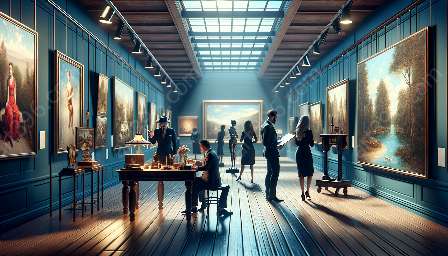Visual art is a rich and complex form of expression that engages our senses in profound ways. By understanding the formal elements of art and applying art criticism, we can explore how artists create visual impact and stimulate our senses.
Understanding Formal Elements of Art
Formal elements of art are the basic components and building blocks that artists use to create visual works. These elements include line, shape, form, value, color, texture, and space. Each of these elements contributes to the overall visual experience and can evoke different sensory responses in the viewer.
Line
Line is a fundamental element that can create a sense of movement, direction, and emotion in visual art. Whether it's a bold, straight line or a delicate, curving line, the use of line can influence the way we perceive and feel about a piece of art.
Shape and Form
Shapes and forms in visual art can create a sense of structure, balance, and volume. Geometric shapes might evoke a different sensory experience than organic, irregular forms, as they play with our perception and spatial awareness.
Value and Color
The use of light and dark in value, as well as the manipulation of color, can profoundly impact our sensory experience of visual art. Warm colors may invoke different emotions than cool colors, and the contrast between light and dark can heighten the dramatic effect of a piece.
Texture and Space
Texture and spatial elements add another layer to the sensory experience of art. The tactile quality of texture and the illusion of depth in space can engage our sense of touch and spatial perception, contributing to a multi-sensory experience.
The Sensory Experience of Visual Art
Art criticism involves analyzing the formal elements of art to interpret the sensory experiences they create for viewers. By examining how artists use formal elements and understanding their impact on the senses, we can gain a deeper appreciation for the expressive power of visual art.
Emotional Impact
Formal elements such as line, color, and composition can convey different emotions and moods, eliciting varied sensory responses from viewers. For example, the use of bold, dynamic lines may generate excitement and energy, while soft, muted colors may evoke a sense of tranquility and calm.
Visual Impact
When artists skillfully combine formal elements, they can create powerful visual impact that captivates and engages the viewer's senses. This interplay of formal elements can guide the viewer's gaze, create focal points, and establish a sense of balance and harmony within the artwork.
Interactive Experience
Visual art invites viewers to engage with the work on a sensory level, prompting them to explore the formal elements and interpret their sensory experiences. This interactive process can deepen the connection between the artwork and the viewer, enriching the overall sensory experience.
Conclusion
By delving into the formal elements of art and understanding their role in shaping the sensory experience of visual art, we can develop a more nuanced appreciation for the expressive power of art. Through the lens of art criticism, we can explore how artists skillfully combine formal elements to create visual impact, evoke emotions, and engage our senses in profound and meaningful ways.

